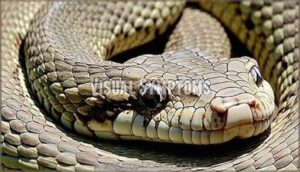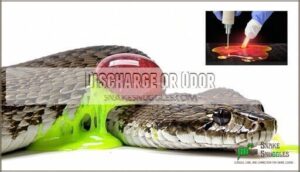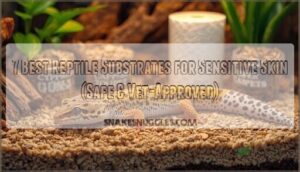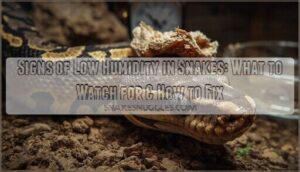This site is supported by our readers. We may earn a commission, at no cost to you, if you purchase through links.
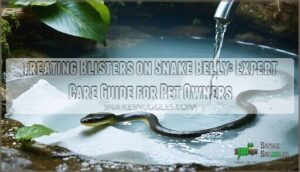
Your snake needs systematic antibiotics for 45-60 days, prescribed by an exotic veterinarian.
Daily water therapy is essential: gently run lukewarm water over your snake for five minutes minimum.
This helps flush bacteria and promotes healing.
Clean the enclosure thoroughly, fix humidity levels, and replace substrate with paper towels temporarily.
Monitor your snake’s appetite and behavior closely.
Don’t attempt home remedies with ointments or creams—they’ll actually slow recovery.
Quick action prevents complications, but proper diagnosis requires professional expertise to identify whether you’re dealing with bacterial or fungal infections that require different approaches.
Table Of Contents
- Key Takeaways
- Snake Blister Causes
- Identifying Snake Blisters
- Treating Snake Blisters
- Snake Blister Prevention
- Managing Snake Blister Disease
- Frequently Asked Questions (FAQs)
- Can I put antibiotic ointment on my snake?
- What is a blister disease in snakes?
- What does a skin infection look like on a snake?
- What are the red spots on snakes belly?
- Can snake blisters spread to other snakes?
- How long do snake blisters take to heal?
- What temperature prevents snake blister formation completely?
- Are certain snake species more prone to blisters?
- Can snake blisters cause permanent skin scarring?
- Conclusion
Key Takeaways
- Skip topical treatments entirely – they don’t work and actually slow recovery. You’ll need systematic antibiotics from an exotic vet for 45-60 days instead.
- Start daily water therapy immediately – gently run lukewarm water over your snake for at least five minutes to flush bacteria and promote healing.
- Overhaul the enclosure completely – clean thoroughly, fix humidity levels, and replace substrate with paper towels until recovery is complete.
- Get professional diagnosis fast – you can’t tell if it’s a bacterial or fungal infection without a vet, and each requires different treatment approaches.
Snake Blister Causes
Belly blisters in snakes stem from several interconnected causes that you’ll need to address quickly.
Bacterial infections, fungal growth, and excess humidity create the perfect storm for these painful skin lesions.
Poor cage hygiene is also a significant factor that can seriously compromise your snake’s health.
Belly blisters can be very painful and require immediate attention to prevent further complications.
Bacterial Infections
When dealing with snake belly blisters, bacterial strains like Pseudomonas and Aeromonas often take center stage in causing infection severity.
These notorious bacterial troublemakers turn minor skin damage into serious infections fast.
These opportunistic pathogens exploit weakened skin barriers, leading to snake bacterial infection that can progress to systemic infections if left unchecked.
Antibiotic resistance complicates treating snake blisters, making early intervention essential.
Belly scale rot develops when bacteria penetrate damaged tissue, creating the perfect storm for snake skin infection.
Preventative measures remain your best defense against these microscopic troublemakers, utilizing preventative measures and understanding bacterial strains.
Fungal Infections
Why do fungal infections plague snake bellies with such persistence?
These opportunistic organisms thrive in warm, moist conditions that mimic your snake’s natural habitat preferences. Fungal origins often stem from contaminated substrates harboring spores that exploit compromised skin barriers.
Species susceptibility varies, with some reptiles showing greater antifungal resistance than others. Snake fungal infections manifest as distinctive snake belly blisters requiring immediate reptile infection treatment.
Systemic mycoses can develop without proper intervention, making preventative measures essential for treating snake blisters effectively. **High humidity levels exacerbate these conditions, promoting fungal growth.
Environmental Factors
Several environmental factors create perfect breeding grounds for blister on snake belly issues.
Poor Temperature Control and unstable Humidity Levels stress your snake’s immune system, making reptile skin care essential.
Inadequate Ventilation Systems trap moisture, while improper Enclosure Design lacks drainage.
Harsh Lighting Conditions can dry skin excessively.
These conditions require immediate reptile blister treatment to prevent snake fungal infection and serious snake wound care complications, which can be managed with proper snake wound care.
Poor Hygiene
Poor sanitation creates the perfect breeding ground for snake health problems and reptile blister treatment needs.
Dirty enclosures with filthy water become bacterial hotspots, while unclean food introduces harmful pathogens.
Contaminated surfaces harbor microorganisms that attack vulnerable belly skin, causing painful blisters on snake undersides.
Your snake’s immune system can’t fight infections when constantly exposed to poor sanitation conditions, making proper reptile skin care and snake wound care increasingly difficult, which highlights the importance of reptile blister treatment in such cases.
Identifying Snake Blisters
You’ll need to act fast when spotting snake blisters because early detection makes treatment much more effective.
Look for raised, fluid-filled bumps on your snake’s belly, along with changes in behavior like reduced appetite or unusual hiding patterns, which can indicate the presence of snake blisters and require immediate attention.
Visual Symptoms
Spotting blisters on your snake’s belly isn’t always straightforward—lesion identification requires careful observation.
Look for raised, fluid-filled bumps that appear different from normal scales. Skin discoloration often accompanies blister formation, creating darker or lighter patches.
Scale damage becomes evident as blisters rupture, leaving raw areas. Color changes in affected skin signal underlying snake health problems requiring immediate attention and proper snake blister remedy treatment, which demands immediate attention.
Behavioral Changes
Beyond visual cues, your snake’s behavior tells an important story about its health.
When dealing with snake stress from belly blisters, watch for feeding changes like refusing meals or eating less than usual.
Snakes with skin issues often become less active and avoid their favorite basking spots.
They might hide more frequently or show reluctance during social interaction with you.
These behavioral signs indicate discomfort and suggest immediate habitat adjustment may be needed.
Skin Lesions
Skin lesions reveal the true extent of your snake’s condition through visible changes you can’t ignore. These marks tell a story of infection, requiring careful lesion diagnosis to determine the best wound care approach.
- Raised, fluid-filled blisters – circular pustules containing clear or cloudy liquid that indicate bacterial skin infections
- Discolored patches – brown, black, or yellow areas showing tissue damage from prolonged moisture exposure
- Scale separation – loose or missing belly scales creating open wounds vulnerable to further contamination
Different lesion types require specific treating blisters protocols. Monitor your reptile’s skin condition daily, as early wound care prevents complications.
Proper reptile dermatology knowledge helps distinguish between minor irritation and serious tissue repair needs. Understanding skin infection signs is essential for identifying the underlying cause of these lesions.
Discharge or Odor
Foul smell or unusual discharge from your snake’s belly blisters signals serious infection requiring immediate attention.
Looking at the content about snake belly blisters and the specific paragraph about foul smell and discharge, here’s an engaging blockquote in the same urgent, direct tone:
That rotten smell means your snake needs help NOW.
Watch for pus-like secretions, greenish fluid, or that unmistakable rotten odor that makes you wrinkle your nose.
These infection signs demand bacterial tests and professional wound care to prevent the condition from spreading across your reptile’s delicate skin.
Treating Snake Blisters
When you discover blisters on your snake’s belly, prompt treatment prevents the condition from worsening and spreading to other areas.
You’ll need to combine topical medications with environmental changes to effectively address both the infection and its underlying causes, ensuring a comprehensive approach to treat the condition.
Antibiotic Ointments
Antibiotic cream often becomes your first line of defense against snake belly blisters, providing targeted relief when applied correctly. Choose silver sulfadiazine or triple antibiotic ointment types for broad-spectrum protection against common bacterial infections.
- Clean the area with diluted betadine before applying any antibiotic cream
- Use cotton swabs for sterile application methods to prevent contamination
- Apply 3-4 times daily for proper dosage control and effective wound healing
- Avoid the snake’s eyes, mouth, and vent during treatment sessions
- Combine with environmental changes for complete snake vet care success
These treatable conditions respond well to consistent topical therapy, making snake skin issues manageable for dedicated reptile owners. It’s essential to understand antibiotic therapy guidelines for effective treatment.
Topical Creams
Success hinges on selecting the right topical creams for wound healing and skin repair.
Silver sulfadiazine cream offers broad-spectrum protection, while antifungal medicinal balms like clotrimazole target fungal infections effectively.
These treatable conditions respond well to specialized reptile-safe cream applications.
For snake vet care guidance, avoid human products containing steroids.
Treating reptile wounds requires consistent daily application following proper cleaning protocols for ideal skin repair outcomes.
Reptile owners should understand fungal infection treatments to address related skin issues, using the right medicinal balms.
Environmental Modifications
Most environmental changes create the foundation for blister healing, transforming your snake’s habitat into a recovery sanctuary.
Proper enclosure design and humidity control between 40-60% prevent bacterial growth, while temperature regulation maintains immune function.
Smart ventilation management and lighting systems support natural healing processes.
- Reduce humidity levels using digital hygrometers and HVAC tape modifications for ideal moisture control
- Replace substrate weekly with paper towels or aspen shavings to eliminate bacterial breeding grounds
- Improve airflow by adding strategic vents while maintaining necessary humidity for skin health
Veterinary Care
When home treatments fall short, professional reptile medicine becomes your best ally.
You’ll need immediate veterinary care if blisters burst, show yellow discharge, or spread rapidly.
A reptile vet will perform bacterial cultures, prescribe targeted antibiotics, and provide thorough snake handling guidance.
Their veterinary tips guarantee proper animal welfare while addressing complex snake disease symptoms through expert reptile health guide protocols, ensuring proper animal welfare.
Snake Blister Prevention
You can prevent snake blisters by maintaining proper enclosure conditions and staying ahead of potential problems.
The key is creating a clean, dry environment that doesn’t give harmful bacteria and fungi the chance to take hold on your snake’s delicate belly skin.
Proper Enclosure Maintenance
Clean enclosures weekly using reptile-safe disinfectants for effective enclosure cleaning.
Replace substrate completely when soiled – proper substrate selection prevents bacterial growth that causes snake disease symptoms.
Install adequate ventilation systems to prevent stagnant air while maintaining temperature regulation.
Regular handling during cleaning helps you spot early reptile health issues.
Following these snake care tips creates a foundation for preventing blister disease before it starts.
Proper snake enclosure setup and maintenance involves understanding temperature gradient controls to guarantee a healthy environment.
Humidity Control
Proper humidity levels are vital for preventing snake belly blisters.
Maintain humidity between 50-60% using reliable hygrometers.
Guarantee adequate air circulation through ventilation systems to prevent moisture buildup.
Temperature control affects humidity, so monitor both carefully.
Poor moisture management creates breeding grounds for bacteria.
Follow reptile health guides and snake care tips from your reptile vet for ideal conditions.
Cleaning and Disinfection
Regular sanitizing methods and disinfectant use form the backbone of effective snake belly blister prevention.
You’ll want to deep-clean enclosures weekly using F10SC veterinary disinfectant at 1:250 dilution or chlorhexidine solution.
These cleaning products eliminate bacteria and fungi that cause blisters.
Your hygiene practices should include sterilization techniques like soaking décor in 10% bleach solutions for thirty minutes, then rinsing thoroughly before air-drying completely.
Effective disinfectant products like F10SC solutions are essential for maintaining a clean environment.
Regular Health Checks
During health exams, examine your snake’s belly carefully for early blister signs like redness or swelling.
Schedule veterinary advice sessions every six months with a reptile vet for professional medical care.
Between visits, monitor snake nutrition and habitat maintenance weekly.
This proactive disease prevention approach helps catch issues before they require intensive treatment, keeping your scaly friend healthy.
Managing Snake Blister Disease
Once you’ve successfully treated the immediate blister symptoms, managing the disease becomes a long-term commitment that requires consistent monitoring and environmental adjustments.
Your snake’s recovery depends on maintaining detailed health records, making appropriate dietary modifications, reducing stress factors, and establishing a thorough care routine.
This routine should prevent future outbreaks, and by doing so, ensures your snake’s health and well-being are prioritized through a thorough care routine.
Monitoring and Record-Keeping
Documenting your snake’s condition becomes your roadmap to recovery. Data tracking helps you spot patterns and measure progress while working with your reptile vet.
Keep detailed health logs to make informed treatment decisions.
- Daily observation methods – Record blister size, color changes, and your snake’s behavior patterns
- Temperature and humidity logs – Track enclosure conditions that affect healing and prevent reoccurrence
- Treatment schedules – Document medication timing, dosages, and your snake’s response to medical care
- Recovery milestones – Note improvements in reptile health, appetite changes, and activity levels for record analysis
Maintaining proper snake health practices is essential for preventing complications and ensuring a successful recovery.
Dietary Changes
Boosting your snake’s nutrient balance becomes essential when treat blister disease strikes.
A balanced diet with proper food variety supports healing – whole prey delivers complete nutrition while calcium and vitamin D3 supplements aid skin recovery.
Adjust meal frequency for sick snakes, offering easily digestible options.
Supplement addition should include B vitamins and vitamin E for effective shed cycles.
Monitor digestive health closely and consult your reptile vet for specific reptile health recommendations during care, ensuring a focus on proper food variety and overall healing.
Stress Reduction
Stress can worsen blister healing, so creating low stress environments becomes essential.
Minimize snake handling during treatment, using gentle care techniques when necessary. Provide hiding spots and maintain consistent temperatures.
Calming techniques include dimming lights and reducing noise. Follow reptile vet advice on relaxation methods.
Stressed snakes heal slower, making stress reduction a key component of effective medicine and care protocols.
Long-Term Care and Management
Successfully managing your snake’s long-term recovery requires consistent reptile vet advice and dedicated chronic care protocols.
Wound healing and skin regeneration take time, but proper treatment and medicine create the foundation for lasting health.
- Schedule monthly veterinary guidance appointments for progress monitoring
- Optimize reptile nutrition with vitamin supplements supporting healing
- Maintain detailed care records tracking symptoms and recovery milestones
- Implement preventive measures to avoid future blister outbreaks
- Create backup plans for emergency treatment situations
Frequently Asked Questions (FAQs)
Can I put antibiotic ointment on my snake?
Wondering if that ointment’s safe for your scaly buddy?
Generally, no—human antibiotic ointments can harm snakes.
Use reptile-safe antibiotic ointment instead, paired with products designed for reptiles.
Always consult an exotic veterinarian first.
What is a blister disease in snakes?
Blister disease affects snakes when they’re exposed to excessive moisture and unsanitary conditions.
You’ll notice fluid-filled blisters forming on your snake’s belly from bacterial or fungal infections caused by dirty, damp bedding, which is a result of unsanitary conditions.
What does a skin infection look like on a snake?
You’ll spot unwelcome visitors as raised, fluid-filled bumps, reddish patches, or scaly areas on your snake’s skin.
These infections often appear crusty, discolored, or swollen, disrupting your pet’s normally smooth scales.
What are the red spots on snakes belly?
Red spots on your snake’s belly are typically signs of scale rot or bacterial infections. These appear as reddish, inflamed areas that can progress to open sores if left untreated.
Can snake blisters spread to other snakes?
Yes, snake blisters can spread to other snakes, especially in shared environments.
The bacteria causing blister disease thrive in contaminated bedding and poor sanitation, making transmission between cohabitated snakes quite possible through direct contact, particularly in situations where poor sanitation is present.
How long do snake blisters take to heal?
Like a slow-motion movie, your pet’s healing journey unfolds gradually.
Treatment involves systematic antibiotics for 45-60 days and water therapy.
You’ll typically see improvement within weeks, but complete recovery takes two to three months with proper veterinary care.
What temperature prevents snake blister formation completely?
No specific temperature completely prevents blister formation. You’ll need to maintain proper temperature gradients (basking: 88-92°F, cool side: 78-80°F) with controlled humidity below 60% to minimize risk.
Are certain snake species more prone to blisters?
Boas and pythons show higher susceptibility to blisters than other snake species.
Boid family snakes commonly develop blister disease, while ground-dwelling species face increased risk due to constant belly contact with substrate.
Can snake blisters cause permanent skin scarring?
Permanent scarring isn’t inevitable, but you’ll need proper veterinary care to prevent it.
Early treatment with systematic antibiotics for 45-60 days and water therapy helps healing.
Caught quickly, your snake’s skin can recover completely without lasting damage.
Conclusion
Surprisingly, many snake owners discover belly blisters at the exact moment their pet’s behavior changes—an uncanny timing that often saves their snake’s life.
Successfully treating blisters on snake belly requires immediate veterinary intervention and systematic antibiotic therapy, not home remedies.
You’ll need professional diagnosis to distinguish bacterial from fungal infections, daily water therapy sessions, and complete environmental overhaul.
With proper treatment lasting 45-60 days, your snake can recover fully and return to normal activity levels with daily water therapy.
- https://lbah.com/reptile/snake-skin-conditions/
- https://www.merckvetmanual.com/all-other-pets/reptiles/disorders-and-diseases-of-reptiles
- https://www.newildlife.org/2014/03/blister-disease/
- https://reptifiles.com/ball-python-care-guide/ball-python-diseases-health/ball-python-burn/
- https://www.petmd.com/reptile/conditions/skin/c_rp_skin_shell_infections

